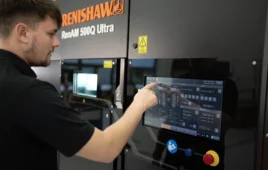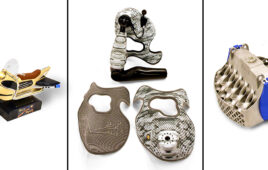With its many technical features, the latest generation of the S1 post-processing system, from AM Solutions, makes short work of de-powdering and cleaning 3D printed components. The features include a swivel-mounted rotary basket for ergonomic loading/unloading and prevention of contaminating the machine environment, swivel-mounted blast nozzles preventing re-contamination of treated parts, and a design in compliance with ATEX standards. The gentle yet intensive processing delivers an easy and safe change of blast media and an easy switch from automatic to manual operation.
Plastic components printed with powder-based 3D printing systems require complete removal of residual powder is surface preparation for subsequent operations like painting or coating. AM Solutions – 3D post-processing technology, a division of the Rösler group and specialized in post-processing, has re-designed its S1 surface treatment system. The plug-and-play unit is suitable for the automatic de-powdering and cleaning of small to mid-size workpiece volumes.
Users can easily switch from automatic to manual operation without time-consuming re-tooling. All the operator has to do is to unlock the rotary basket and move it to the rear of the blast cabinet. This provides a workspace for the manual handling and blasting of somewhat larger components. The design ensures that the operator is not exposed to any moving parts so that no additional safety features are necessary.
The integrated rotary basket allows fully automatic processing of batches up to 25 liters and a maximum batch weight of 50 kg. The basket design ensures optimal distribution and mixing of the components during the blast operation. This, in combination with the pivoting blast nozzles, guarantees the effective and gentle blast treatment of the components in short cycle times. Depending on the finishing task, the shot blast operation can be run with either glass beads or a suitable plastic media. Once the blast cycle is complete, contrary to conventional cabinets, where the blast nozzles are tilted upwards, in the S1 the blast nozzles are automatically swiveled out of the basket. This prevents any powder accumulated on the blast nozzle holder to fall back into the basket and re-contaminate the cleaned components during the subsequent shakeout.
For loading and unloading the basket swivels to the large opening in the cabin front but remains completely within the blast chamber. This allows the ergonomic loading and unloading of workpieces without the risk of contaminating the immediate machine environment with powder.
The PLC of the S1 allows the storing of multiple blast programs with workpiece specific parameters like blast pressure and basket RPM. These parameters are continuously monitored during the complete process. They can be stored in the machine controls or transmitted to a higher-level computer system. In case of deviations from the specified parameters, the PLC provides an acoustic or visual warning.
Another feature of the S1 is that the inside of the cabinet and the rotary basket is lined with an antistatic polyurethane coating. The precisely defined shore hardness of the basket lining prevents any color contamination of the workpieces. The powder swirling around during the blast process is explosive. Equipment suppliers are frequently passing this potential problem on to the equipment operators by demanding that the amount of powder carried into the machine cannot exceed a certain limit. AM Solutions – 3D post-processing technology has resolved this issue by using motors and valves that are in compliance with ATEX standards.
Because of the relatively low noise emission of <=80 dB(A) – when blasting with 3 bar – and the air-tight machine doors the S1 can be operated without safety glasses and noise protection.
The machine is equipped with two viewing windows (for automatic and manual blasting). An “air curtain” prevents the blast media from hitting the window panes.
AM Solutions – 3D post processing
www.solutions-for-am.com
Filed Under: Make Parts Fast






